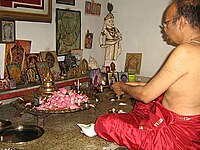Shrine
This article needs additional citations for verification. (April 2011) |
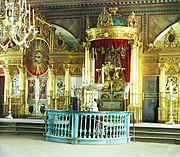


A shrine (Latin: scrinium "case or chest for books or papers"; Old French: escrin "box or case")[1] is a sacred space dedicated to a specific deity, ancestor, hero, martyr, saint, daemon, or similar figure of respect, wherein they are venerated or worshipped. Shrines often contain idols, relics, or other such objects associated with the figure being venerated.[2] A shrine at which votive offerings are made is called an altar.
Shrines are found in many of the world's religions, including Christianity, Islam, Hinduism, Buddhism, Chinese folk religion, Shinto, indigenous Philippine folk religions, and Germanic paganism as well as in secular and non-religious settings such as a war memorial. Shrines can be found in various settings, such as churches, temples, cemeteries, or as household shrines. Portable shrines are also found in some cultures.[3]
Types of shrines
[edit]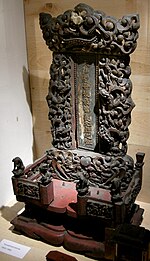
Temple shrines
[edit]Many shrines are located within buildings and in the temples designed specifically for worship, such as a church in Christianity, or a mandir in Hinduism. A shrine here is usually the center of attention in the building and is given a place of prominence. In such cases, adherents of the faith assemble within the building in order to venerate the deity at the shrine. In classical temple architecture, the shrine may be synonymous with the cella.[citation needed]
Household shrines
[edit]Historically, in Hinduism, Buddhism and Roman Catholicism, and also in modern faiths, such as Neopaganism, a shrine can commonly be found within the home or shop.[4] This shrine is usually a small structure or a setup of pictures and figurines dedicated to a deity that is part of the official religion, to ancestors or to a localised household deity.[5]
Yard shrines
[edit]Small outdoor yard shrines are found at the bottom of many peoples' gardens, following various religions, including historically, Balinese Hinduism, Christianity. Many consist of a statue of Christ, Virgin Mary or a saint, on a pedestal or in an alcove, while others may be elaborate booths without ceilings, some include paintings, statuary, and architectural elements, such as walls, roofs, glass doors and ironwork fences.[citation needed]
In the United States, some Christians have small yard shrines; some of these resemble side altars, since they are composed of a statue placed in a niche or grotto; this type is colloquially referred to as a bathtub madonna.[6]
Wayside shrines
[edit]Religious images, usually in some sort of small shelter, placed by a road or pathway, sometimes in a settlement or at a crossroads.[citation needed]
Religious shrines
[edit]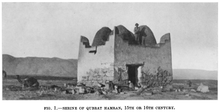
Shrines are found in many religions. As distinguished from a temple, a shrine usually houses a particular relic or cult image, which is the object of worship or veneration. A shrine may also be constructed to set apart a site which is thought to be particularly holy, as opposed to being placed for the convenience of worshipers. Shrines therefore attract the practice of pilgrimage.[7][8]
Christianity
[edit]Shrines are found in many forms of Christianity, but not all. Catholicism, the largest denomination of Christianity,[9] has many shrines, as do Orthodox Christianity, Anglicanism and some forms of Lutheranism.
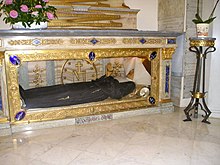
In the Roman Catholic Church, a local diocesan bishop or archbishop can designate a local (arch)diocesan shrine. For a shrine to be a national shrine, the approval of the country's Episcopal Conference is required. Similarly, the approval of the Holy See at the Vatican in Rome is required for it to be "international. The Roman Catholic 1983 Code of Canon Law, canons 1230 and 1231 read: "The term shrine means a church or other sacred place which, with the approval of the local Ordinary, is by reason of special devotion frequented by the faithful as pilgrims. For a shrine to be described as national, the approval of the Episcopal Conference is necessary. For it to be described as international, the approval of the Holy See is required."[10]
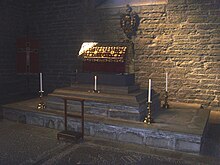
In unofficial, colloquial Catholic use, the term "shrine" is a niche or alcove in churches, especially larger ones, used by parishioners when praying privately. They were formerly also called devotional altars, since before the Second Vatican Council they contained small side altars or bye-altars. Shrines are always centered on some image (for instance, a statue, painting, mural or mosaic) of Jesus Christ, of Mary, mother of Jesus, or of a saint, and may have had a reredos behind them.[citation needed]
Today, Mass would not necessarily be celebrated at them. They are simply used to aid or give a visual focus for prayers. Side altars, where Mass could actually be celebrated, were used in a similar way to shrines by parishioners. Side altars are specifically dedicated to the Blessed Virgin Mary, mother of Jesus, to her husband Saint Joseph, or to other saints.[citation needed]
A nativity scene could also be viewed as a shrine, as the definition of a shrine is any holy or sacred place.[citation needed]
Islam
[edit]Islam's holiest structure, the Kaaba (within the Al-Haram Mosque) in the city of Mecca, though an ancient temple (in the sense of a "house of God"), may be seen as a shrine[11][12][13] due to it housing a respected relic called the Hajar al-Aswad and also being the partial focus of the world's largest pilgrimage practice, the Hajj. A few yards away, the mosque also houses the Maqam Ibrahim ("Abraham's station") shrine containing a petrosomatoglyph (of feet) associated with the patriarch and his son Ishmael's building of the Kaaba in Islamic tradition.[14][15] The Green Dome sepulcher of the Islamic prophet Muhammad (where his burial chamber also contains the tombs of his friend Abu Bakr and close companion Umar) in Medina, housed in the Masjid an-Nabawi ("The Mosque of the Prophet"),[16][17][18] occurs as a greatly venerated place and important as a site of pilgrimage among Muslims.
Sunni Islam
[edit]
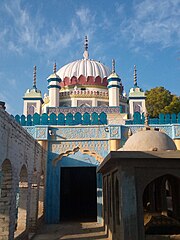
Two of the oldest and notable Islamic shrines are the Dome of the Rock and the smaller Dome of the Chain built on the Temple Mount in Jerusalem.[19] The former was built over the rock that marked the site of the Jewish Temple and according to Islamic tradition, was the point of departure of Muhammad's legendary ascent heavenwards (al-Mi'raj).[20][21]
More than any other shrines in the Muslim world, the tomb of Muhammad is considered a source of blessings for the visitor.[22] Among sayings attributed to Muhammad include one stated as: "He who visits my grave will be entitled to my intercession."[22][23][24] Visiting Muhammad's tomb after the pilgrimage is considered by the majority of Sunni legal scholars to be recommended.[25]
The early scholars of the salaf, Ahmad Ibn Hanbal (d. 241 AH), Ishaq Ibn Rahwayh (d. 238 SH), Abdullah ibn Mubarak (d. 189 AH) and Imam Shafi'i (d. 204 AH) all permitted the practice of ziyāra to Muhammad's tomb.[26] The hadith scholar Qadi Ayyad (d. 554 AH) stated that visiting Muhammad was "a Sunna of the Muslims on which there was consensus, and a good and desirable deed."[27]
Ibn Hajar al-Asqalani (d. 852 AH) explicitly stated that travelling to visit the tomb of Muhammad was "one of the best of actions and the noblest of pious deeds with which one draws near to God, and its legitimacy is a matter of consensus."[28] Similarly, Ibn Qudamah (d. 620 AH) considered ziyāra of Muhammad to be recommended and also seeking intercession directly from Muhammad at his grave.[29][30]
The tombs of other Muslim religious figures are also respected. The son of Ahmad ibn Hanbal, one of the primary jurists of Sunnism, reportedly stated that he would prefer to be buried near the mausoleum of a saintly person than his own father.[31] While in some parts of the Muslim world the mausoleums of the tombs are seen as simply places of ziyāra of a religious figure's gravesite (Mazār/Maqbara), in others (such as the Indian subcontinent) they are treated as proper shrines (Dargah).[32][33][34]
Opposition to tomb shrines by the Salafi and Wahhabi groups
[edit]Many modern Islamic reformers oppose the building (and sometimes the visitation of) tomb shrines, viewing it as a deviation from true Islam.[35] This mainly includes followers of the Wahhabi and Salafi movements, which believe that shrines over graves encourage idolatry/polytheism (shirk) and that there is a risk of worshipping other than God (the dead).[36][37][38][39]
The founder of the Wahhabi movement, Muhammad ibn Abd al-Wahhab derived the prohibition to build mosques over graves from a hadith attributed to the Muhammad in which he said "May God curse the Jews and Christians who make the graves of their prophets into places of worship; do not imitate them."[40] Additionally, he commanded leveling of the graves (taswiyat al-qubur), which the scholar Imam Al-Shafi'i supported.[39]
The Wahhabi movement was heavily influenced by the works of the medieval Hanbali theologian Ibn Taymiyyah who was considered by them to be the "ultimate authority on a great number of issues".[41] One of these issues was the position on the visitation of Muhammad's tomb. According to Ibn Taymiyyah all the ahadith encouraging the visitation of the tomb are fabricated (mawdu‘), are not contained in the six main collections of hadith or Musnad Ahmad ibn Hanbal, and violate tawhid al-uluhiya.[42]
This view of Ibn Taymiyyah was rejected by some mainstream Sunni scholars both during his life and after his death. The Shafi'i hadith master Ibn Hajar al-Asqalani stated that "This is one of the ugliest positions that has been reported of Ibn Taymiyya".[43] The Hanafi hadith scholar Ali al-Qari stated that, "Amongst the Hanbalis, Ibn Taymiyya has gone to an extreme by prohibiting travelling to visit the Prophet – may God bless him and grant him peace"[44] Qastallani stated that "The Shaykh Taqi al-Din Ibn Taymiyya has abominable and odd statements on this issue to the effect that travelling to visit the Prophet is prohibited and is not a pious deed."[45]
Shia
[edit]Shias have several mazars dedicated to various religious figures important in their history, and several elaborate shrines (Marqad/Maqam) are dedicated to Shia religious figures, most notably in Iraq (such as in the cities of Karbala,[46] Najaf,[47][48] Samarra[49]) and in Iran (such as in the cities of Qom[50] and Mashad[51]).
Specific examples of Shia shrines include the Al-Askari Shrine,[52] and Imam Hussein Shrine.[53] Other Shia shrines are located in the eponymous cities of Mazar-e Sharif ("The Noble Mausoleum") in Afghanistan,[54] and Mashhad (al-Rida) ("Martyrium [of Ali Rida ]") in Iran.[55] The Mausoleum of Ruhollah Khomeini in Tehran houses the tombs of Ruhollah Khomenei, the leader of Iran's 1978–79 revolution, his wife, and a few other related people.[56][57][58]
Sufi
[edit]
In popular Sufism, one common practice is to visit or make pilgrimages to the tombs of saints, renowned scholars, and righteous people. This is a particularly common practice in the Indian subcontinent, where famous tombs include of saints such as Sayyid Ali Hamadani in Kulob, Tajikistan; Afāq Khoja, near Kashgar, China; Lal Shahbaz Qalandar in Sindh; Ali Hujwiri in Lahore, Pakistan; Bahauddin Zakariya in Multan Pakistan; Moinuddin Chishti in Ajmer, India; Nizamuddin Auliya in Delhi, India; and Shah Jalal in Sylhet, Bangladesh.[59] Likewise, in Fez, Morocco, a popular destination for pious visitation is the Zaouia Moulay Idriss II.[60] The area around Timbuktu in Mali also has many historic Sufi shrines which were destroyed by Islamist in recent years. Many of these have since been rebuilt.[61][62][63] A saint's tomb is a site of great veneration where blessings or baraka continue to reach the deceased holy person and are deemed (by some) to benefit visiting devotees and pilgrims according to Sufi beliefs. In order to show reverence to Sufi saints, kings, and nobles provided large donations or waqf to preserve the tombs and renovate them architecturally.[64][65] Over time, these donation, rituals, annual commemorations formed into an elaborate system of accepted norms. These forms of Sufi practise created an aura of spiritual and religious traditions around prescribed dates.[66] Many orthodox or Islamic purists denounce these visiting grave rituals, especially the expectation of receiving blessings from the venerated saints.[67]
Baháʼí Faith
[edit]
The two most well-known Baháʼí Faith shrines serve as the resting places for the respective remains of the two central figures of the Baháʼí Faith, the Báb and Bahá'u'lláh. They are the focal points of a Baháʼí pilgrimage:
- The Shrine of the Báb in Haifa, Israel.[68]
- The Shrine of Bahá'u'lláh in Acre, Israel.[69]
Other sites have been designated as Baháʼí Shrines, the most notable being the home of William Sutherland Maxwell and May Maxwell in Montreal, Quebec, Canada.[70]
Buddhism
[edit]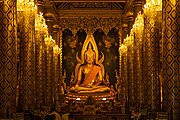

In Buddhism, a shrine refers to a place where veneration is focused on Lord Buddha or one of the bodhisattvas or arahants. Monks, nuns and laity will pay homage with the aide of Buddhist iconography at these shrines which are also used for Buddhist meditation.
Typically, Buddhist shrines contain a statue of either Gautama Buddha, or (in the Mahayana and Vajrayana forms of Buddhism), one of the various Buddhas or bodhisattvas.[71] They also commonly contain candles, along with offerings such as flowers, purified water, food, and incense. Many shrines also contain sacred relics, such as the famous sacred tooth of Lord Buddha installed at a shrine in Sri Lanka.
Site-specific shrines in Buddhism, particularly those that contain relics of past Buddhas and revered enlightened monks, are often designed in the traditional form known as the Stupa or Cetiya.
Philippine folk religions
[edit]Ancient Filipinos, and Filipinos today who continue to adhere to the indigenous Philippine folk religions generally do not have so-called "temples" of worship under the context known to foreign cultures.[72][73][74] However, they do have sacred shrines, which are also called as spirit houses.[72] They can range in size from small roofed platforms, to structures similar to a small house (but with no walls), to shrines that look similar to pagodas, especially in the south where early mosques were also modeled in the same way.[75] These shrines were known in various indigenous terms, which depend on the ethnic group association.[note 1] They can also be used as places to store taotao and caskets of ancestors. Among Bicolanos, taotao were also kept inside sacred caves called moog.[72][76][77][78]
During certain ceremonies, anito are venerated through temporary altars near sacred places. These were called latangan or lantayan in Visayan and dambana or lambana in Tagalog.[note 2] These bamboo or rattan altars are identical in basic construction throughout most of the Philippines. They were either small roof-less platforms or standing poles split at the tip (similar to a tiki torch). They held halved coconut shells, metal plates, or martaban jars as receptacles for offerings. Taotao may sometimes also be placed on these platforms.[72][76]
Other types of sacred places or objects of worship of diwata include the material manifestation of their realms. The most widely venerated were balete trees (also called nonok, nunuk, nonoc, etc.) and anthills or termite mounds (punso). Other examples include mountains, waterfalls, tree groves, reefs, and caves.[72][73][79][80][81]
Germanic paganism
[edit]In Germanic paganism, types of shrines were employed, but terms for the shrines show some level of ambiguity:
- Hörgrs, which may have originally exclusively referred to "holy places", whereas its Old English cognate hearg could mean "holy grove" and/or "temple, idol"[82]
- Vés (Old Norse) or wēohs (Old English), referring to either a types of shrines or sacred enclosures. The term appears in skaldic poetry and in place names in Scandinavia (with the exception of Iceland), often in connection with a Norse deity or a geographic feature. The name of the Norse god Vé, refers to the practice.[83]
Hinduism
[edit]In Hinduism, a shrine is a place where gods or goddesses are worshipped. Shrines are typically located inside a Hindu temple of various forms. Most Hindu families have a household shrine as well. For example, according to memoirs of Stephen Huyler of his visits to some Hindu homes, a part of home was dedicated to the household shrine. Here, image of a deity was placed and offered prayers, instead of visits to a temple.[84] Among Tamil Hindu homes, according to Pintchman, a shrine in Kitchen is more common. If the family is wealthy, it may locate the household shrine in a separate room.[85]
Taoism
[edit]
The line between a temple and a shrine in Taoism is not fully defined; shrines are usually smaller versions of larger Taoist temples or small places in a home where a yin-yang emblem is placed among peaceful settings to encourage meditation and study of Taoist texts and principles. Taoists place less emphasis on formalized attendance but include ritualized worship than other Asian religions; formal temples and structures of worship came about in Taoism with the influence from Buddhism.[citation needed]
Frequent features of Taoist shrines include the same features as full temples, often including any or all of the following features: gardens, running water or fountains, small burning braziers or candles (with or without incense), and copies of Taoist texts such as the Tao Te Ching, Zhuangzi or other texts by Lao Tzu, Chuang Tzu or other Taoist sages.[citation needed]
Confucianism
[edit]A number of Confucian temples and shrines exist across the sinophone world, it is a temple for the veneration of Confucius, great sages, eminent philosophers of Confucianism and also the Disciples of Confucius. These temples are known as "Temples of Confucius" (孔廟) or "Temples of Literature" (文廟). Unlike Taoist temples, Confucian temples usually do not installed the images of Confucius but the tablets. It is argued that the temple was to honour Confucius's teachings, not Confucius himself. The temples consist of gardens and then a large pavilion where incense is burnt. The tablet or sometime an image of Confucius is usually placed in the main shrine.
Confucian shrines exist outside of China too, mainly in Japan, Korea and Vietnam. There are also quite a number of Confucian shrines in Taiwan like Tainan Confucian Temple and Taipei Confucius Temple, they are well-maintained by the government. However, many Taoist temples dedicated a shrine for the worship of Confucius or Wen Chang Di Jun (God of Literature).
Secular shrines
[edit]In some countries around the world, landmarks may be called "historic shrines."[citation needed] Notable shrines of this type include:
- The Alamo in San Antonio, Texas, U.S.
- Fort McHenry in Baltimore, Maryland, U.S.
- Touro Synagogue in Newport, Rhode Island, U.S.
- Shrine of Remembrance, a war memorial in Melbourne, Australia
- Shrine of Remembrance, a war memorial in Brisbane, Australia
- Lenin's Mausoleum in Moscow, Russia
- Kumsusan Palace of the Sun in Pyongyang, North Korea
Halls of fame also serve as shrines into which single or multiple individuals are inducted on the basis of their influence upon regions, cultures or disciplines. Busts or full-body statues are often erected and placed alongside each other in commemoration. This includes Halls of Fame that honor sports athletes, where an athlete's entrance to the hall is commonly described as "enshrinement".
By extension the term shrine has come to mean any place dedicated completely to a particular person or subject such as the Shrine of the Sun in Colorado Springs, Colorado.[86]
See also
[edit]- Australian Aboriginal sacred sites
- Earth mysteries
- Holiest sites in Islam (Shia)
- Holiest sites in Islam (Sunni)
- Indigenous Philippine shrines and sacred grounds
- List of shrines
- Numen
- Makeshift/roadside memorial
- Sacred natural site
- Sanctuary
- Shrines to the Virgin Mary
- Shriners or the Ancient Arabic Order of the Nobles of the Mystic Shrine
- Shinto shrine
Notes
[edit]- ^ Known as magdantang in Visayan and ulango or simbahan in Tagalog. Among the Itneg, shrines are known tangpap, pangkew, or alalot (for various small roofed altars); and balaua or kalangan (for larger structures). In Mindanao, shrines are known among the Subanen as maligai; among the Teduray as tenin (only entered by shamans); and among the Bagobo as buis (for those built near roads and villages) and parabunnian (for those built near rice fields).(Kroeber, 1918)
- ^ Also saloko or palaan (Itneg); sakolong (Bontoc); salagnat (Bicolano); sirayangsang (Tagbanwa); ranga (Teduray); and tambara, tigyama, or balekat (Bagobo)
References
[edit]- ^ Harper, Douglas. "shrine". Online Etymology Dictionary.
- ^ Shrine. thefreedictionary.com
- ^ Portable Tibetan Shrine Archived 2015-10-19 at the Wayback Machine. British Museum
- ^ Patricia Chang (February 23, 2007). "Shrines in shops in Chinatown". Downtown Express. 19 (41). Archived from the original on February 28, 2007. Retrieved December 16, 2009.
- ^ Household Shrines. Gualala Arts
- ^ Front Yard Shrines Archived 2009-03-27 at the Wayback Machine. catholichomeandgarden.com
- ^ Catholic Shrines. Sacred Destinations
- ^ David Tyson (1997). "Shrine pilgrimage in Turkmenistan as a means to understand Islam among the Turkmen". Central Asia Monitor. 1.
- ^ Wikipedia Roman Catholic Church
- ^ PART III : SACRED PLACES AND TIMES Archived 2019-12-09 at the Wayback Machine. ourladyswarriors.org
- ^ "Masjid al-Haram - Oxford Islamic Studies Online". www.oxfordislamicstudies.com. Archived from the original on March 26, 2018. Retrieved 2018-08-12.
The Grand Mosque of Mecca in western Saudi Arabia. Along with the Prophet Muhammad 's Mosque in Medina, it is one of the two holiest shrines in Islam, its spiritual center, and the focus of the hajj pilgrimage. A place of worship even before the time of Muhammad, the mosque is organized around the Kaaba, a pre-Islamic "House of God" founded by Abraham and Ishmael, toward which all Muslim prayer is directed. The present layout of the Grand Mosque evolved from a series of enlargements during the Umayyad and Abbasid periods, Ottoman refinements, and recent Saudi additions.
- ^ "Kaʿbah | shrine, Mecca, Saudi Arabia". Encyclopædia Britannica. Retrieved 2018-08-13.
- ^ "Great Mosque of Mecca | Overview, Description, & Facts". Encyclopædia Britannica. Retrieved 2018-08-13.
- ^ Peters, F.E. (1994). "Another Stone: The Maqam Ibrahim". The Hajj. Princeton, New Jersey: Princeton University Press. pp. 16–17. ISBN 9780691026190.
- ^ "Maqam-e-Ibrahim shines ... like visitors' faith". 25 September 2016.
- ^ "Al-Masjid An-Nabawy". www.olemiss.edu. Archived from the original on 2017-08-31. Retrieved 2018-08-12.
- ^ "Important Sites: The Prophet's Mosque". Inside Islam. 2012-02-16. Retrieved 2018-08-13.
The most distinct aspect of the mosque is a green dome called the Dome of the Prophet and marks the location of the Prophet Muhammad's tomb. Abu Bakr and Umar, the first and second caliphs, are buried near the Prophet.
- ^ "Prophet's Mosque | mosque, Medina, Saudi Arabia". Encyclopædia Britannica. Retrieved 2018-08-13.
- ^ Slavik, Diane (2001). Cities through Time: Daily Life in Ancient and Modern Jerusalem. Geneva, Illinois: Runestone Press. p. 60. ISBN 978-0-8225-3218-7.
- ^ M. Anwarul Islam and Zaid F. Al-hamad (2007). "The Dome of the Rock: Origin of its octagonal plan". Palestine Exploration Quarterly. 139 (2): 109–128. doi:10.1179/003103207x194145. S2CID 162578242.
- ^ Nasser Rabbat (1989). "The meaning of the Umayyad Dome of the Rock". Muqarnas. 6: 12–21. doi:10.2307/1602276. JSTOR 1602276.
- ^ a b Diem, Werner; Schöller, Marco (2004-01-01). The Living and the Dead in Islam: Indices. Otto Harrassowitz Verlag. p. 46. ISBN 9783447050838.
- ^ Bayhaqi. Sunan. Vol. V. p. 245.
- ^ Iyyad, Qadi. Shifa. Vol. II. p. 71.
- ^ Diem, Werner; Schöller, Marco (2004-01-01). The Living and the Dead in Islam: Indices. Otto Harrassowitz Verlag. p. 55. ISBN 9783447050838.
- ^ Diem, Werner; Schöller, Marco (2004-01-01). The Living and the Dead in Islam: Indices. Otto Harrassowitz Verlag. p. 23. ISBN 9783447050838.
- ^ Rapoport, Yossef; Ahmed, Shahab (2010-01-01). Ibn Taymiyya and His Times. Oxford University Press. p. 290/291. ISBN 9780195478341.
- ^ Rapoport, Yossef; Ahmed, Shahab (2010-01-01). Ibn Taymiyya and His Times. Oxford University Press. p. 291. ISBN 9780195478341.
- ^ Zargar, Cameron (2014). The Hanbali and Wahhabi Schools of Thought As Observed Through the Case of Ziyārah. The Ohio State University. pp. 28–29.
- ^ Ibn Qudāmah, Abū Muḥammad, Al-Mughnī, (Beirut: Bayt al-Afkār al-Dawliyyah, 2004), p 795.
- ^ Diem, Werner; Schöller, Marco (2004-01-01). The Living and the Dead in Islam: Indices. Otto Harrassowitz Verlag. pp. 7–8. ISBN 9783447050838.
- ^ Dasgupta, Piyali (7 January 2014). "799th birthday celebrations of Hazrat Nimazuddin Auliya, held recently at the Hazrat Nizamuddin Dargah in Delhi". The Times of India. Retrieved 13 June 2018.
- ^ "797th Urs of Khawaja Moinuddin Chisty begins in Ajmer". Sify. Archived from the original on 1 October 2012. Retrieved 18 February 2012.
- ^ "Pakistan's Sufis defiant after Islamic State attack on shrine kills 83". Reuters. 17 February 2017. Retrieved 17 February 2017.
- ^ "Shrine - Oxford Islamic Studies Online". www.oxfordislamicstudies.com. Archived from the original on February 24, 2021. Retrieved 2018-08-10.
Many modern Islamic reformers criticize visits to shrines as mere superstition and a deviation from true Islam.
- ^ "Mecca for the rich: Islam's holiest site 'turning into Vegas'". The Independent. Archived from the original on 24 October 2018. Retrieved 2018-08-10.
In the eyes of Wahabis, historical sites and shrines encourage "shirk" – the sin of idolatry or polytheism – and should be destroyed. When the al-Saud tribes swept through Mecca in the 1920s, the first thing they did was lay waste to cemeteries holding many of Islam's important figures. They have been destroying the country's heritage ever since. Of the three sites the Saudis have allowed the UN to designate World Heritage Sites, none are related to Islam.
- ^ "Saudi Arabia Bulldozes Over Its Heritage". Time. Archived from the original on 10 August 2018. Retrieved 2018-08-10.
Wahhabism, the prevailing Saudi strain of Islam, frowns on visits to shrines, tombs or religio-historical sites, on grounds that they might lead to Islam's gravest sin: worshipping anyone other than God.
- ^ "Medina: Saudis take a bulldozer to Islam's history". The Independent. Archived from the original on 10 August 2018. Retrieved 2018-08-10.
In most of the Muslim world, shrines have been built. Visits to graves are also commonplace. But Wahabism views such practices with disdain. The religious police go to enormous lengths to discourage people from praying at or visiting places closely connected to the time of the Prophet while powerful clerics work behind the scenes to promote the destruction of historic sites.
- ^ a b Ondrej, Beranek; Tupek, Pavel (July 2009). Naghmeh, Sohrabi (ed.). From Visiting Graves to Their Destruction: The Question of Ziyara through the Eyes of Salafis (PDF). Crown Paper (Crown Center for Middle East Studies/Brandeis University). Brandeis University. Crown Center for Middle East Studies. p. 16. Archived (PDF) from the original on 10 August 2018.
Ibn Taymiyya argues that the prohibition against treating graves as places of prayer is not based only on the impurity of such places;58 the true reason lies in concern over the temptation of worshiping the dead (khawf al-fitna bi alqabr). This was the opinion of Imam al-Shafi'i and other salaf, who commanded leveling these graves (taswiyat al-qubur) and effacing what might arouse the temptation (ta'fiyat ma yatafattan bihi minha).
- ^ Ondrej, Beranek; Tupek, Pavel (July 2009). Naghmeh, Sohrabi (ed.). From Visiting Graves to Their Destruction: The Question of Ziyara through the Eyes of Salafis (PDF). Crown Paper (Crown Center for Middle East Studies/Brandeis University). Brandeis University. Crown Center for Middle East Studies. p. 19. Archived (PDF) from the original on 10 August 2018.
Relying mainly on hadiths and the Qur'an, Ibn 'Abd al-Wahhab's most famous work, The Book of God's Unicity (Kitab al-tawhid), describes a variety of shirk practices, such as occultism, the cult of the righteous (salih), intercession, oaths calling on other than God himself, sacrifices or invocational prayers to other than God, and asking other than Him for help. Important things about graves are remarked on in a chapter entitled "About the Condemnation of One Who Worships Allah at the Grave of a Righteous Man, and What if He Worships [the Dead] Himself." Ibn 'Abd al-Wahhab starts by quoting a hadith: "Umm Salama told the messenger of Allah about a church she had seen in Abyssinia in which there were pictures. The Prophet said: 'Those people, when a righteous member of their community or a pious slave dies, they build a mosque over his grave and paint images thereon; they are for God wicked people.' They combine two kinds of fitna: the fitna of graves and the fitna of images." He then continues with another hadith: "When the messenger of Allah was close to death, he . . . said: 'May Allah curse the Jews and Christians who make the graves of their prophets into places of worship; do not imitate them.'" From this hadith Ibn 'Abd al-Wahhab derives the prohibition of building places of worship over graves, because that would mean glorification of their inhabitants, which would amount to an act of worship to other than Allah.
- ^ Zargar, Cameron (2014). The Hanbali and Wahhabi Schools of Thought As Observed Through the Case of Ziyārah. The Ohio State University. p. 3.
- '^ Ondrej, Beranek; Tupek, Pavel (July 2009). Naghmeh, Sohrabi (ed.). From Visiting Graves to Their Destruction: The Question of Ziyara through the Eyes of Salafis (PDF). Crown Paper (Crown Center for Middle East Studies/Brandeis University). Brandeis University. Crown Center for Middle East Studies. p. 15. Archived (PDF) from the original on 10 August 2018.
Ibn Taymiyya criticizes hadiths encouraging visitation of the Prophet's grave, pronouncing them all forgeries (
mawdu) and lies (kidhb). According to him, most famous are "He who performs the pilgrimage and does not visit me, has shunned me" and "Who visited my grave must ask me for intercession." Ibn Taymiyya notes that although some of these hadiths are part of Daraqutni's collection, they are not included in the main hadith collections of Bukhari, Muslim, Abu Dawud, and Nasa'i, nor are they part of the Musnad of Ibn Hanbal. He observes that with regard to visiting the Prophet's grave, ulama rely only upon hadiths according to which the Prophet must be greeted (al-salam wa al-salat alayhi).56 As for the contents of hadiths encouraging visitation, they contradict the principle of tawhid al-uluhiya. - ^ Rapoport, Yossef; Ahmed, Shahab (2010-01-01). Ibn Taymiyya and His Times. Oxford University Press. p. 290. ISBN 978-0-19-547834-1.
- ^ Rapoport, Yossef; Ahmed, Shahab (2010-01-01). Ibn Taymiyya and His Times. Oxford University Press. p. 292. ISBN 978-0-19-547834-1.
- ^ Rapoport, Yossef; Ahmed, Shahab (2010-01-01). Ibn Taymiyya and His Times. Oxford University Press. p. 293. ISBN 978-0-19-547834-1.
- ^ "Free at last from Isis, millions of Muslims stage the greatest religious march in the world". The Independent. Retrieved 2018-08-12.
The Arbaeen has provided many modern-day Shia martyrs, murdered by Saddam Hussein, al-Qaeda and Isis, but its purpose is to mourn the martyrdom of Imam Hussein, the revered Shia leader, killed in the battle for Kerbala in AD680. The long ritual walk to his golden-domed shrine in that city – some walkers spend 10 or 12 days on the road from Basra or Kirkuk, others two or three days from Najaf – comes on the 40th day of the mourning period as religious fervour reaches its peak among the faithful.
- ^ "Najaf - Oxford Islamic Studies Online". www.oxfordislamicstudies.com. Archived from the original on August 13, 2018. Retrieved 2018-08-12.
One of Iraq's two holiest cities (Karbala is the other one). Reputedly founded by the Abbasid caliph Harun al-Rashid in 791. A Shii religious center located south of Baghdad and six miles west of Kufa. Site of Ali ibn Abi Talib's (the first Shii imam) tomb. Kufa retained its importance as the locus of Shii activities until the fifteenth century, when Najaf replaced it. Hospices, schools, libraries, and Sufi convents were built around the shrine. Late nineteenth-century Qom replaced Najaf as the center of Shii learning; this was reversed with the rise of Ayatollah Khomeini (d. 1989) and Muhammad Baqir al-Sadr (d. 1980).
- ^ Abid, S. K., Imam Ali Shrine, institution and cultural monument: the implications of cultural significance and its impact on local conservation management, CiteSeerX 10.1.1.735.1355
- ^ Carnelos, Marco (18 July 2018). "Like it or not, Iran will continue to be the most powerful player in Iraq". Middle East Eye. Retrieved 2018-08-12.
Every year, during the annual Shia pilgrimages to the Holy Shrines in Najaf, Karbala and Samarra, millions of Iranians, in numbers two or three times higher than the entire traditional Hajj pilgrimage to Mecca, cross the Iraqi border; they are spontaneously fed and housed by the poorest Iraqi Shia families free of any charge.
- ^ "Qom - Oxford Islamic Studies Online". www.oxfordislamicstudies.com. Archived from the original on August 12, 2018. Retrieved 2018-08-12.
Leading center of Shii theological seminaries and site of Hazrat-i Masumah, which is the second most important Shii shrine in Iran. Burial site of numerous shahs of the Safavid and Qajar dynasties and many religious scholars. Major center of political activity in 1963, 1975, and 1977 – 79 . The shrine and the Borujerdi mosque are important places for leading communal prayers and sermons. The shrine has been an economic and state institution, the focus of endowments and commercial rents dedicated to its upkeep, and a symbolic site whose opening and closing each day are accompanied by state-appointed guards extolling the sovereignty of the reigning government under God. Qom's madrasas in particular were a major center of resistance to the Pahlavi monarchy. When Ayatollah Khomeini returned to Iran from exile, he went immediately to Qom, which remains a key seat of the ulama's educational and political organizations.
- ^ "Imam Reza shrine complex (Mashhad, Iran): Mosque: Detail of tile - Yale University Library". findit.library.yale.edu. Retrieved 2018-08-12.
- ^ "Samarra Shrine Restoration in Iraq | United Nations Educational, Scientific and Cultural Organization". www.unesco.org. Retrieved 2018-08-13.
On Wednesday, 22 February 2006, unidentified assailants bombed the Al-Askari Mosque in Samarra, one of the holiest Shia'a sites in Iraq, containing the shrines of Ali Al-Hadi and Hassan Al-Askari, two of the most important Shia'a Imams, and the mausoleum of Mohammad Al Mehdi, known as the "hidden Imam", and hosting millions of pilgrims annually.
- ^ "Iraq Significant Site 011 - Baghdad - Al-Kadhimayn Mosque and Shrine". www.cemml.colostate.edu. Archived from the original on 2019-12-18. Retrieved 2018-08-13.
- ^ "Afghanistan Significant Site 147. Mazar-i Sharif". www.cemml.colostate.edu. Archived from the original on 2019-12-18. Retrieved 2018-08-12.
- ^ "Sacred Sites: Mashhad, Iran". sacredsites.com. Archived from the original on 2010-11-27. Retrieved 2006-03-13.
- ^ "Ayatollah Khomeini's mausoleum: A symbol of Iranian pride". USA TODAY. Retrieved 2018-08-12.
- ^ "What is the mausoleum of Ayatollah Khomeini?". The Indian Express. 2017-06-07. Retrieved 2018-08-12.
- ^ "Iranians mourn Khomeini's widow". BBC News. 2009-03-22. Archived from the original on 12 August 2018. Retrieved 2018-08-12.
- ^ Annemarie Schimmel (1975). Mystical Dimensions of Islam. Univ of North Carolina Press. p. 238. ISBN 978-0-8078-1271-6.
- ^ Métalsi, Mohamed (2003). Fès: La ville essentielle. Paris: ACR Édition Internationale. pp. 192–194. ISBN 978-2867701528
- ^ "Timbuktu mausoleums in Mali rebuilt after destruction". BBC News. 2015-07-19.
- ^ "United Nations News Centre". UN News Service Section. 20 July 2015.
- ^ "Masons rebuild Timbuktu tombs after militant destruction – World – The Star Online". thestar.com.my.
- ^ Jafri, S.Z.H. and Reifeld, H., 2006. The Islamic path: sufism, society, and politics in India. Rainbow Publishers.
- ^ The Islamic Path: Sufism, Politics, and Society in India (2006)
- ^ The Islamic Path: Sufism, Politics, and Society in India. (2006)
- ^ Jafri, S.Z.H.; Reifeld, Helmut (2006). The Islamic Path: Sufism, Society, and Politics in India. New Delhi: Rainbow Publishers. ISBN 978-8186962855. OCLC 70335822.
- ^ Baháʼí World Centre (2007). "Shrine of the Báb". Baháʼí World Centre. Retrieved 2009-02-03.
- ^ Baháʼí World Centre (2007). "Shrine of Bahá'u'lláh". Baháʼí World Centre. Retrieved 2009-02-03.
- ^ Baháʼí Community of Canada (2014). "Baháʼí Shrine in Canada". Baháʼí Community of Canada. Retrieved 2014-12-06.
- ^ Srine Archived 2019-12-24 at the Wayback Machine. buddhamind.info
- ^ a b c d e William Henry Scott (1994). Barangay: Sixteenth Century Philippine Culture and Society. Quezon City: Ateneo de Manila University Press. ISBN 978-9715501354.
- ^ a b Stephen K. Hislop (1971). "Anitism: a survey of religious beliefs native to the Philippines" (PDF). Asian Studies. 9 (2): 144–156
- ^ Ferdinand Blumentritt (1894). "Alphabetisches Verzeichnis der bei den philippinischen Eingeborenen üblichen Eigennamen, welche auf Religion, Opfer und priesterliche Titel und Amtsverrichtungen sich beziehen. (Fortsetzung.)". Wiener Zeitschrift für die Kunde des Morgenlandes. 8. Orientalisches Institut, Universität Wien. p. 147.
- ^ Madale, N. T. (2003). In Focus: A Look at Philippine Mosques. National Commission for Culture and the Arts.
- ^ a b A. L. Kroeber (1918). "The History of Philippine Civilization as Reflected in Religious Nomenclature". Anthropological Papers of the American Museum of Natural History. XXI (Part II): 35–37.
- ^ Cole, Fay-Cooper; Gale, Albert (1922). "The Tinguian; Social, Religious, and Economic life of a Philippine tribe". Field Museum of Natural History: Anthropological Series. 14 (2): 235–493
- ^ Gregorio F. Zaide (2017). "Filipinos Before the Spanish Conquest Possessed a Well-Ordered and Well-Thought-Out Religion". In Tanya Storch (ed.). Religions and Missionaries around the Pacific, 1500–1900. The Pacific World: Lands, Peoples and History of the Pacific, 1500-1900, Volume 17. Routledge. ISBN 9781351904780.
- ^ Jean-Paul G. Potet (2017). Ancient Beliefs and Customs of the Tagalogs. Lulu Press Inc. p. 235.
- ^ Teodoro A. Agoncillo & Oscar M. Alfonso (1969). History of the Filipino People. Malaya Books. p. 42.
- ^ Francisco R. Demetrio (1973). "Philippine Shamanism and Southeast Asian Parallels" (PDF). Asian Studies. 11 (2): 128–154.
- ^ Rudolf Simek (2007), translated by Angela Hall. Dictionary of Northern Mythology, p. 156. D.S. Brewer. ISBN 0-85991-513-1
- ^ Simek, Rudolf (2007), translated by Angela Hall. Dictionary of Northern Mythology, page 335. D.S. Brewer. ISBN 0-85991-513-1. and Orchard, Andy (1997). Dictionary of Norse Myth and Legend, page 173. Cassell. ISBN 0-304-34520-2
- ^ Huyler, Stephen P. (Author); Moore, Thomas (Forward (1999). Meeting god : elements of Hindu devotion. New Haven, USA: Yale Univ. Press. pp. 42, 71–72, 89. ISBN 9780300079838.
{{cite book}}:|first1=has generic name (help) - ^ Pintchman, Tracy (2007). Women's lives, women's rituals in the Hindu tradition. New York: Oxford University Press. p. 96. ISBN 9780195177060.
- ^ "Will Rogers Shrine of the Sun". Artsopolis Network. Archived from the original on January 1, 2012. Retrieved December 30, 2011.


